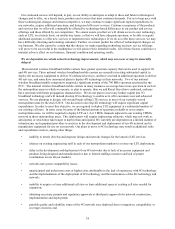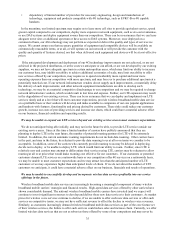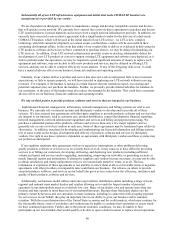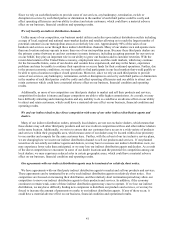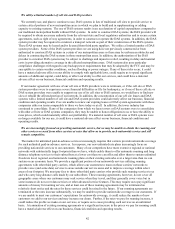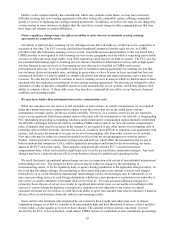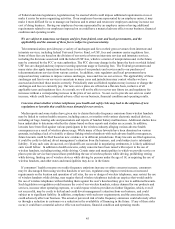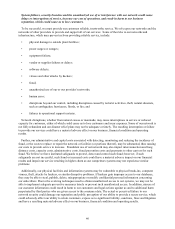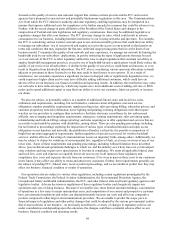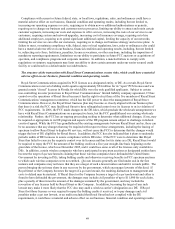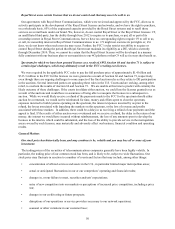Metro PCS 2009 Annual Report Download - page 54
Download and view the complete annual report
Please find page 54 of the 2009 Metro PCS annual report below. You can navigate through the pages in the report by either clicking on the pages listed below, or by using the keyword search tool below to find specific information within the annual report.42
We utilize a limited number of cell site and DAS providers.
We currently use, and plan to continue to use, DAS systems in lieu of traditional cell sites to provide service to
certain critical portions of new metropolitan areas in which we plan to build and in supplementing or adding
capacity to existing systems. The use of DAS systems results in an acceleration of capital expenditures compared to
our traditional metropolitan builds without DAS systems. In order to construct DAS systems, the DAS provider will
be required to obtain necessary authority from the relevant state and local regulatory authorities and to secure certain
agreements, such as right of way agreements, in order to construct or operate the DAS systems. In addition, the DAS
system provider may be required to construct a transport network as part of their construction of the DAS systems.
These DAS systems may be leased and/or licensed from third party suppliers. We utilize a limited number of DAS
system providers. Some of the DAS system providers we are using have not previously constructed or been
authorized to construct DAS systems in certain of our metropolitan areas so there may be unforeseen obstacles and
delays in constructing the DAS systems in those metropolitan areas. In addition, the authorization of the DAS
provider to construct DAS systems may be subject to challenge and injunctive relief, resulting in delay and material
costs in providing alternative coverage in the affected metropolitan areas. DAS systems also pose particular
compliance challenges with regard to any backup power requirements that may be adopted by the FCC and may be
susceptible to certain weather conditions, such as flooding or power outages. If any of these risks occur, it could
have a material adverse effect on our ability to comply with applicable laws, could require us to spend significant
amounts of additional capital, could delay or affect our ability to offer our services, and could have a material
adverse effect on our business, financial condition and operating results.
If our master agreement with one of our cell site or DAS providers were to terminate, or if the cell site or DAS
system providers were to experience severe financial difficulties or file for bankruptcy, or if one of these cell site or
DAS system providers were unable to support our use of its cell sites or DAS systems, we would have to find new
sites or rebuild the affected portion of our network. In addition, the concentration of our cell site leases and DAS
systems with a limited number of cell site and DAS system providers could adversely affect our business, financial
condition and operating results if we are unable to renew our expiring leases or DAS system agreements with these
companies either on terms comparable to those we have today or at all. In addition, the tower industry has
continued to consolidate. If any of the companies from which we lease towers or DAS systems were to consolidate
with other cell site or DAS systems companies, they may be unable to honor obligations to us or have the ability to
raise prices, which could materially affect our profitability. If a material number of cell sites or DAS systems were
no longer available for our use, it could have a material adverse effect on our business, financial condition and
operating results.
We are increasingly focused on providing nationwide service, but we may be unable to obtain the roaming and
other services we need from other carriers at rates that allow us to provide such nationwide service and still
remain competitive.
The market for unlimited paid-in-advance services increasingly requires that carriers provide nationwide coverage
for such unlimited paid-in-advance services. In response, our new unlimited rate plans increasingly focus on
providing nationwide services to our customers. Many of our competitors have more extensive regional or national
networks with substantially larger footprints than we have, which enable them to offer automatic roaming and long
distance telephone services to their subscribers at a lower cost than we can offer and allow them to sustain unlimited
fixed-rate local, regional, and nationwide roaming plans on their existing networks over a larger area than we can
sustain on an economic basis. We provide a significant portion of our nationwide services utilizing roaming
agreements with other third party carriers, which allows our customers to roam on those carriers’ networks to
provide voice (and some data) services to areas outside our service areas and to improve coverage within select
areas of our footprint. We must pay fees to these other third party carriers who provide such roaming services to us
and who carry long distance calls made by our subscribers. These roaming agreements, however, do not cover all
geographic areas where our customers may seek service when they travel, and they generally cover voice but in
some instances do not cover data services or other advanced service features. This may require us to pay significant
amounts of money for roaming service, and at least one of these roaming agreements may be terminated on
relatively short notice and the rates for these services could be raised in the future. If our roaming agreements are
terminated or the rates increase substantially, we may be unable to provide nationwide coverage to our customers. If
we are unable to meet our customers’ expectations for nationwide coverage, it could reduce the number of new
customers we add to our services and may increase our churn. Further, if the rates we pay for roaming increase, it
could reduce the profits we make on our services, or require us to cease providing such services on an unlimited
basis. A termination of existing roaming agreements or a significant increase in the prices we pay for roaming could
have a material adverse effect on our business, financial condition and operating results.




